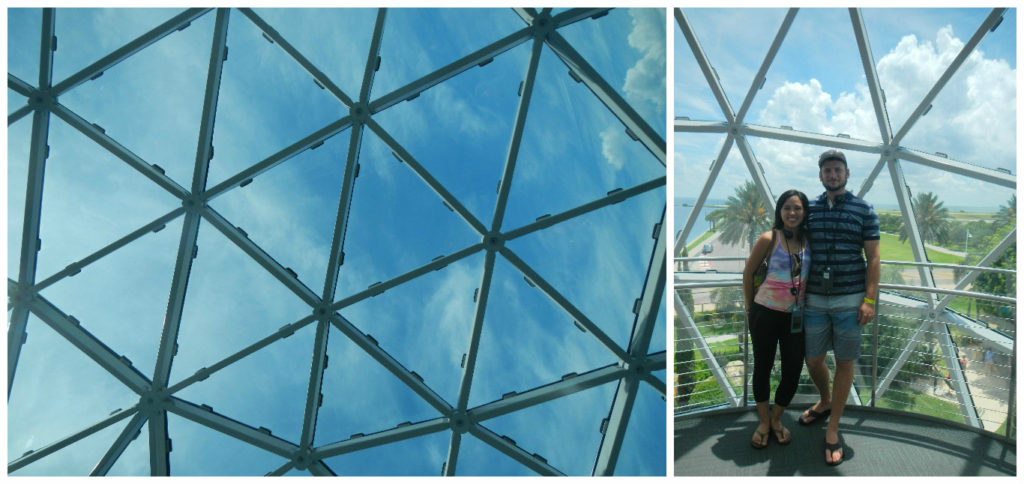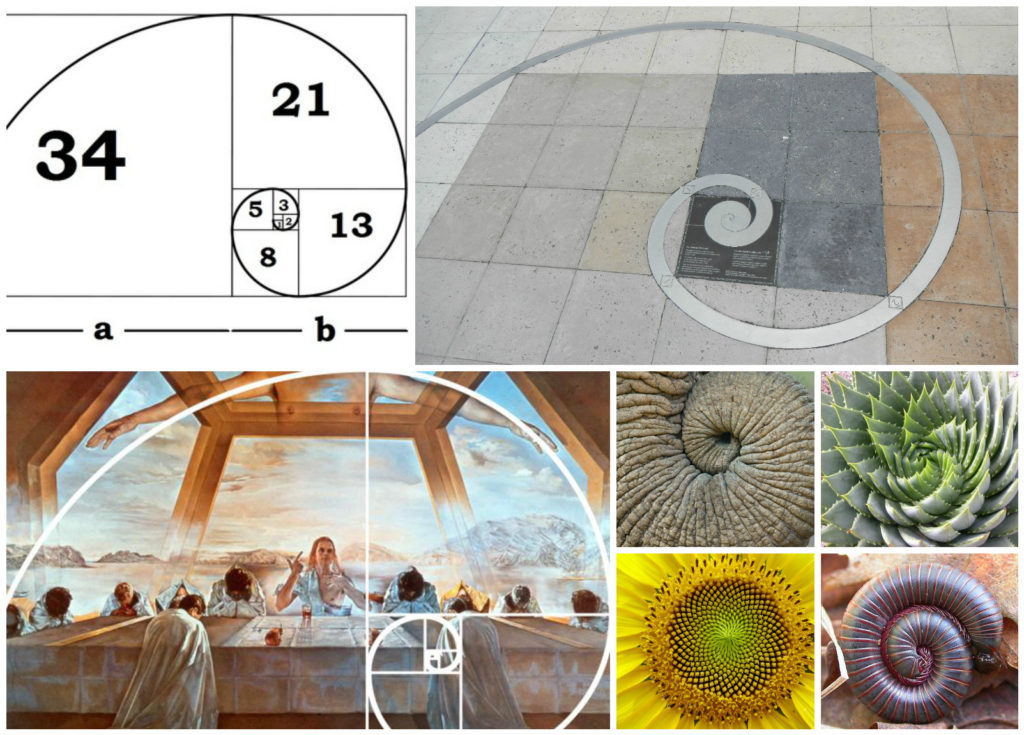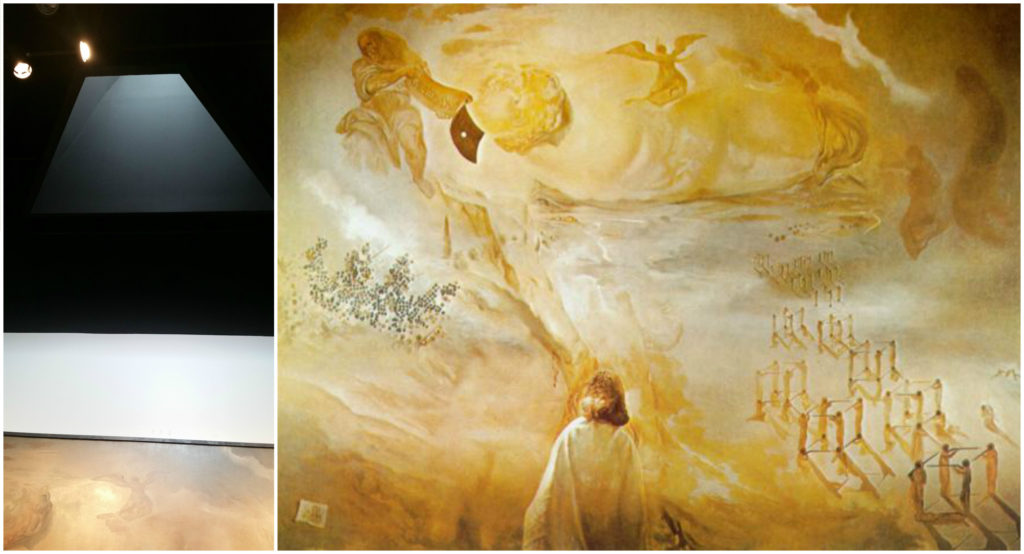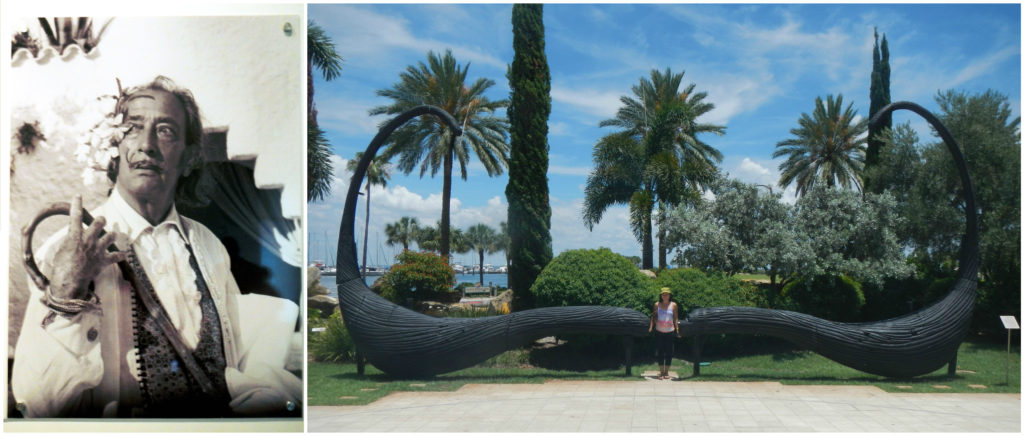We made our first stop on this Florida leg of vacation the Dalí museum in St. Petersburg. A relaxing morning and a short drive over some cool bridges and beautiful water got us to the new building. Jon visited the Dalí museum years ago when it was still a small warehouse. $38 million dollars later, it’s a gorgeous structure with a masculine concrete block embraced by the fluid and crystalline glass, a tessellated figure of a woman’s body embracing it.
There are 1,062 panes of triangular glass comprising the delicate structure of the woman’s body, and no two are exactly alike (and neither are any of the two helix joining pieces!). The concrete was poured on site, an impressive feat, I learned, since ensuring the color/consistency of the concrete is pretty difficult outside of regulated factory conditions. Concrete also forms the helix-inspired spiraling staircase, an homage to Dalí’s interest in the double helix of DNA.

Fun fact from the architecture tour: the stair railing is a single piece of steel. If you start at the bottom and don’t let go, you’ll go up and end up all the way back down at the bottom! All of Dalí’s works are housed on the 3rd floor in order to protect them from the possibility of flooding during a storm or hurricane (the concrete is reinforced).
The helix wasn’t the only shape or structure of interest to Dalí. He particularly loved the golden ratio, a mathematical spiral based on the Fibonacci sequence.

This spiral shape is found in nature, architecture, and art. The Parthenon is thought to be based on this ratio, as is the Taj Mahal and many classical artistic works.
This museum provides a full retrospective of Salvador Dalí’s life, from his beginning stages of art through to the end. His early works are very much in line with artists before him. He showed classical style of realist and impressionist paintings of traditional still life, landscape, or self-portraits.


This still life of bread is a monumental piece in Dalí’s portfolio. He said it was the most satisfying painting of bread he’d ever created and because he had mastered this style, he was able to let it go and experiment with the more avant garde.
He was expelled from the School of Fine Arts in Madrid after he told the tribunal they were not qualified to examine him. How could they know more about Rafael than he?
Dalí created his works in natural lighting, so one of the coolest features of this new building in terms of housing his artwork, is that there are skylights to let in sunlight (with a filtered pane to protect the art, of course) so that we can appreciate the colors of each work as he intended them.



This dual image of “Gala Contemplating the Mediterranean Sea Which at Twenty Meters Becomes the Portrait of Abraham Lincoln (Homage to Rothko)” demonstrates also Dalí’s interest in math and science. After reading an article in the Scientific American about the number of pixels needed to create an image, Dalí decided he would create his image using 121 pixels. The painting itself has a hint painted within it of the two images it contains. The bright spot at the top is a rising sun, formed by a crucified Jesus’ head (Son of God; he was punny!).

The painting “Weaning of Furniture Nutrition” fantastically shows his talents as an artist and surrealist. He paints the boats on the dock so realistically they could be a photograph and juxtaposes the image of this woman with a piece of her body, in the shape of furniture, missing. The woman represents his childhood nanny, as does the drawer stand furniture, both now weaned from his adult life.

“The Hallucinogenic Toreador” was part of his of “monumental works” series—his largest paintings, averaging 1 each year or so which focused on his most current interests as well as references to his own earlier works. This painting was inspired by a set of Venus brand pencils he purchased one day. Aside from the 31 images of Venus repeated throughout, flies swarm within this painting as well, the symbol of St. Narciso, where legend has said swarms of them came forth from the tomb of the Catalan icon to ward off French forces. The figure in the bottom right corner represents Dalí as a boy.
If you can’t see the toreador right away, look at the green cloth in the center; this forms the toreador’s tie. The shadow of Venus to its right outlines the toreador’s face, and the red cloth covering the Venus is the toreador’s matador cape. The flies/dots to the left form the sequined cape of the toreador and the ones above the face form his cap. You can see a subtle bull shape right below the colored dots on the left side of the painting too.

Interestingly, Salvador had an older brother, also named Salvador, who died 9 months and some odd days before he was born resulting in him feeling plagued with the question “who is the real Salvador?” The pointillism dots that create the face are made of dark and light cherries, representing he and his brother. Under the dark area of his nose you can see a classic pair of cherries sharing a stem. There is a brighter section in the nose where four cherries create a molecule-type structure.
The museum audio guide also pondered whether this painting referred to his good friend Federico García Lorca, a Spanish playwright and poet who Dalí may have considered his brother in art. García Lorca was killed by the military forces during the Spanish Civil war, and the soldiers in the bottom right of the painting may be an allusion to this.

He didn’t just paint; Dalí designed art pieces, jewelry, and performances. The replica of his car design below, is something he dreamed up to contrast the fact that so many times people rush to the car in the rain. What if when you rushed to the car, he thought, it was the interior that housed a thunderstorm (complete with mermaid!)? The diver/driver represented Dalí himself. He was neighbors with the inventor of this retro diving suit and once gave a lecture fully dressed in it. However this suit had bolts and needed the air to be pumped in manually. The guys pumping air in were so excited to see what Dalí was going to do, they left their posts to watch. Only after he fell over limply, did they realize it was not part of the act and rescued him from the suit just in time.
Eccentric in everything from his mustache to the greatest works in his career, Dalí gave us so much to consider. His interests in the golden ratio, math and science actually led him full circle back to religion. If the same patterns are so prevalent how can we deny the work of a greater force in this world? God or not, it’s a compelling argument.


Love the rich details of the art work . Thank you for taking me with you in this journey
.